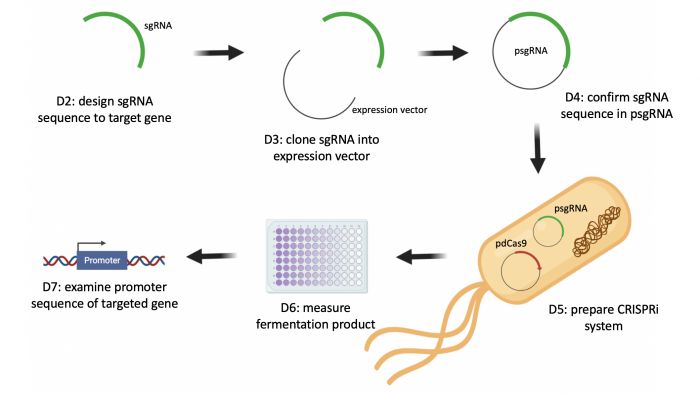20.109(S22):Module 2
Contents
Module 2: metabolic engineering
Clustered Regularly Interspaced Short Palindromic Repeats (CRISPR) refers to a family of genes that are maintained within prokaryotic genomes. The purpose of these genes is to provide protection against viral infection as a form of acquired immunity that is passed genetically to progeny cells. The CRISPR sequences enable the recognition of specific nucleotide sequences. This feature of the CRISPR system has been leveraged to develop tools that allow researchers to make precise alterations in DNA / RNA.
In this module you will use a modified CRISPR system to modulate transcription in E. coli. Specifically, you will use a CRISPR-based interference system to target a gene within the fermentation pathway of E. coli such that either ethanol or acetate production is increased.
Research goal: Increase the yield of commercially valuable byproducts in E.coli using CRIPSRi technology to target genes involved in mixed-acid fermentation pathway.
Lab links: day to day
M2D1: Complete in-silico cloning of pdCas9 expression plasmid
M2D2: Design gRNA sequence for CRIPSRi system
M2D3: Clone psgRNA expression plasmid
M2D4: Confirm gRNA sequence in psgRNA expression plasmid
M2D5: Prepare for induction of CRISPRi system
M2D6: Complete CRISPRi experiment and measure fermentation products
M2D7: Examine features in gRNA-targeted genomic sequences
M2D8: Organize figures and outline text for Research article
Major assignments
Journal Club presentation
Research article
References
- CRISPR interference (CRISPRi) for sequence-specific control of gene expression. Nature Methods. (2013) 8: 2180-2196.
- Metabolic engineering of Escherichia coli for production of mixed-acid fermentation end products. Frontiers in Bioengineering and Biotechnology. (2014) 2:1-12.

